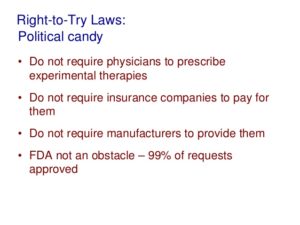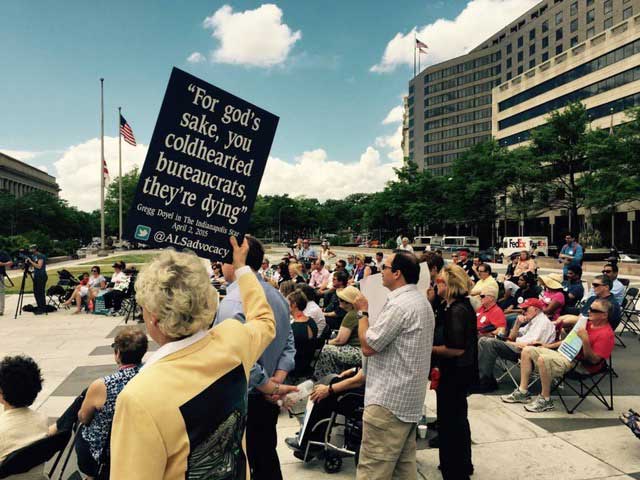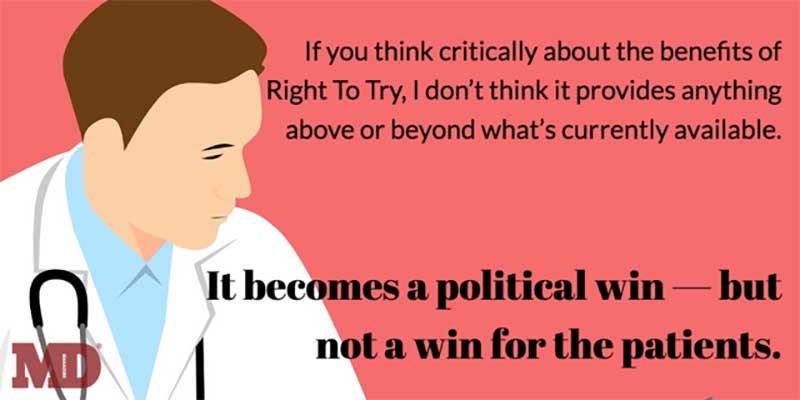“I am proud to keep another promise to the American people…
that they will be cured, that they will be helped…We’re going
to be saving tremendous numbers of lives. And it’s so great
…that we’re all on the front line together.
(President Trump, 5/30/2018)
Has it finally happened? Have U.S. lawmakers finally come to their senses and passed a law that will put health care within the reach of every American, rich or poor? Vice President Pence insisted the new law would “advance the interests of the American people.” President Trump said he was overjoyed to be signing a bill that would give every American “health, hope, and a fighting chance.”
Hold your horses. Looks like we’ve been snookered again. Right to Try, the bill that passed, will not make a major difference to millions of patients or provide life-saving opportunities for affordable care and treatment. The bill that would have, variously called universal health care, single payer or Medicare-for-all, landed in the congressional circular file alongside other bills with huge popular support (think gun control laws, climate change legislation, consumer protection guarantees). Looks like we’ll just have to limp along with the terminally ill Affordable Care Act (aka Obamacare).
The bill that passed the Senate (with only one dissenting vote) on August 3, 2017, the House on May 29, 2018, and was signed into law by the President on May 30, like most legislation passed by Congress with enthusiastic support from the President, is another attempt to declaw the federal oversight dogs (in this case the FDA) and return the American public to a Hobbesian state of nature where no agency exists to contain the baser instincts of free-market healthcare. The bill was larded with the usual load of campaign contributions from the likes of Charles and David Koch and right-wing and libertarian foundations and think tanks on the order of the Goldwater Institute and Americans for Prosperity. The requisite amount of money having been pocketed by the more larcenous members of Congress (think all of them) and the President, Right to Try (known by critics as Right to Die) became the law of the land on May 30, 2018 (40 states have already passed versions of it).
Right to Try may be many things but, critics charge, its ability to improve health outcomes for American patients is problematic. Not so, declares the RTT website : “Right to Try gives life-saving hope back to those who lost it.” To which more than 100 groups representing patients and research organizations reply “No way, José.”
What does RTT actually do? Not very much according to some experts “  …If it’s nothing more than a right to beg a company, that right already exists and you’re really not doing much to help anybody gain access to anything.” RTT allows terminally ill patients to “beg” drug makers to release experimental drugs that have cleared the first and lowest of the FDA’s three-phase process for determining a drug’s safety and effectiveness. In many cases, the drugs sought by terminally ill patients have been tested for safety (not effectiveness) on less than 30 patients. What could possibly go wrong in this unregulated free-for-all? According to an article in the New England Journal of Medicine (1/22/2018) — “…Most of the drugs that succeed in Phase 1 turn out to be too unsafe and ineffective for clinical use.”
…If it’s nothing more than a right to beg a company, that right already exists and you’re really not doing much to help anybody gain access to anything.” RTT allows terminally ill patients to “beg” drug makers to release experimental drugs that have cleared the first and lowest of the FDA’s three-phase process for determining a drug’s safety and effectiveness. In many cases, the drugs sought by terminally ill patients have been tested for safety (not effectiveness) on less than 30 patients. What could possibly go wrong in this unregulated free-for-all? According to an article in the New England Journal of Medicine (1/22/2018) — “…Most of the drugs that succeed in Phase 1 turn out to be too unsafe and ineffective for clinical use.”
So why is the wing-nut slice of U.S. politics cheering the movement on? Concern for the terminally ill? Skeptics like Dr. David Gorski, oncologist and professor, discount compassion in favor of rule one of free-market capitalism: eliminate regulation. As he sees it “the goal of the right-to-try movement is not to help terminally ill patients. It’s to diminish and weaken the FDA…” Pishtosh, say supporters, “Congress is on the cusp of delivering real hope to millions of Americans who are desperately looking for potential life-saving treatments that are just out of their reach…” (Koch-funded Americans for Prosperity letter to congress). Even Trump-appointed FDA Commissioner Gottlieb has his doubts: “Neither the FDA nor physicians or patients can compel a company to make a product available — and companies may decline requests for a variety of reasons. The most skeptical (and conspiratorial) see far darker motivations impelling the push for the bill “Right-to-try is not (and never was) about helping terminally ill patients. If passed, the next step will be to push to make right-to-try apply to more than just terminally ill patients”
Which side sits nearest the angels? Those who claim RTT laws are right up there with sliced bread or those who see RTT as an insidious precursor of the destruction of the system of federal oversight of the health care industry? For most politicians, it’s s distinction without a difference.  Legislators who want to keep their jobs are not about to come off as unsympathetic to the plight of terminally ill patients, facts be damned. 94 senators got the message and voted aye as did 250 representatives. President Trump, himself a master of base-pleasing rhetoric chimed in— “[RTT gives patients hope] that they will be cured, that they will be helped, that they will be able to be with their families for a long time…”
Legislators who want to keep their jobs are not about to come off as unsympathetic to the plight of terminally ill patients, facts be damned. 94 senators got the message and voted aye as did 250 representatives. President Trump, himself a master of base-pleasing rhetoric chimed in— “[RTT gives patients hope] that they will be cured, that they will be helped, that they will be able to be with their families for a long time…”
Sounds good, doesn’t it? The real “skinny” on RTT laws is a lot less glamorous. For openers, it really doesn’t change the way things work. As many health care professionals have pointed out, the decision to grant or deny permission for experimental use of a drug resides where it always has —with the drug maker. Many of these companies are reluctant to release a drug after a successful Phase 1 trial for reasons of cost and legal liability (although state and federal RTT laws immunize drug companies and doctors against malpractice and negligence claims). A bigger fly in the ointment is affordability. Unless you are very rich, RTT laws are useless as insurance coverage is virtually non-existent and experimental drugs are generally incredibly expensive. Even worse, if the therapy causes serious side-effects, get out your checkbook. Your health insurance very likely won’t cover needed medical treatment. Even if you require treatment for a condition unrelated to an experimental drug you’ve taken, many insurers will use RTT as an excuse to deny coverage for any medical procedure for six months or more. For the not so rich terminally ill, RTT laws may promise hope of miraculous cures but their chief effect is usually medical bankruptcy.
The tiger we really have by the tail are the murderous dynamics of American health care. RTT laws are merely the trees in a whole forest of expensive, overrated and underachieving medical care. Dysfunctional, with outcomes heavily dependent on patients’ bank accounts, the system serves only the tiny slice of patients at the top of the economic food chain. In 2015, the CDC (Centers for Disease Control) reported that 10% of American adults could not afford to take their medicines as prescribed. In the uninsured population, that percentage rose to 14%. The poorest adults (annual income of $27,300 for a family of 3) were predictably the most likely to skip prescribed doses of medicines. A key statistic in the report — Medicare patients who, unlike the majority of Americans, receive the benefits of a single payer health insurance system, were the most likely to take their meds as prescribed.
Over-priced drugs aren’t the only culprits when it comes to America’s lopsided health care metrics. Headlines in all the major U.S. publications paint a dismal picture of a health care system in decline — “U.S. healthcare tab to keep rising led by higher cost for drugs and services, government report says” (L.A. Times 2/14/2018), The rising cost of diabetes care in the USA (Dept. of Health and Human Services 5/4/2016), Cost of Care: Health care costs rising to unsustainable levels” (Forbes, 11/7/17)
U.S. health care has become just another restrictive gated community available only to those with wealth and power. In no other country do health care CEOS make more in one day than their average citizens make in one year. Where’s the political outrage over that stunning example of income inequality? You won’t find it in Washington. The people in other countries get universal health care, Americans get Right to Try.
816 total views, 1 views today

